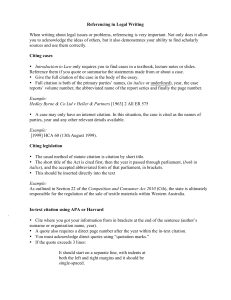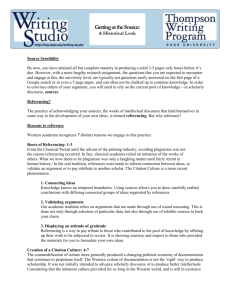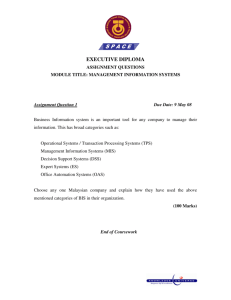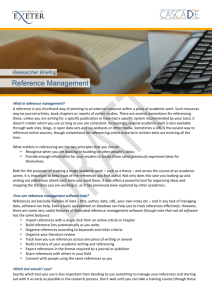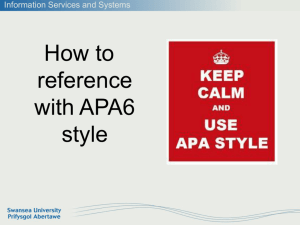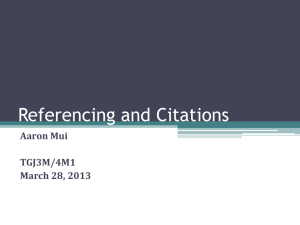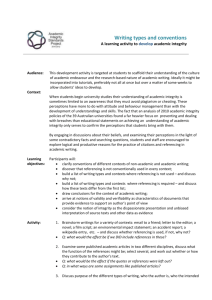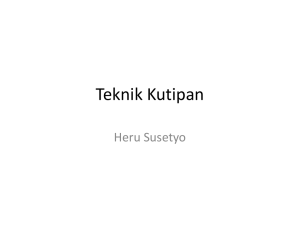Research skills
advertisement
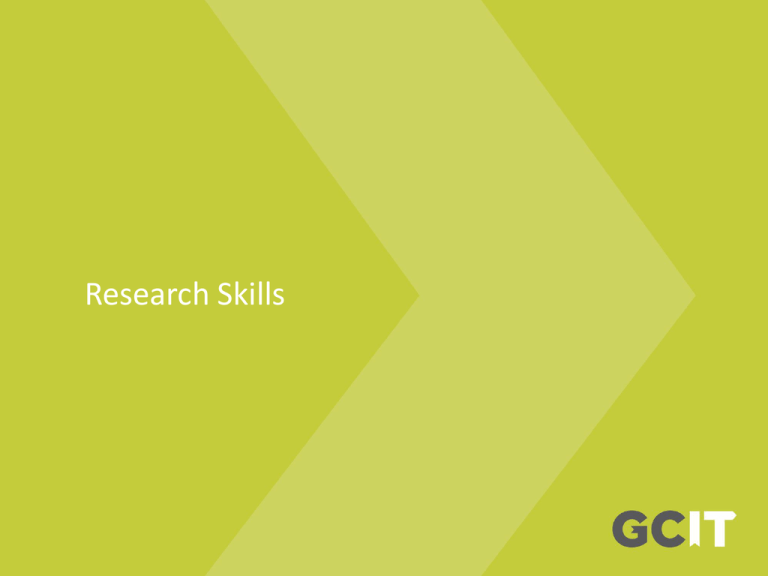
Research Skills Overview of this Session Introduction to defining your research topic Look at sources of information Library collection Online subscription databases Internet Advance searching Evaluating information Referencing Defining your research topic Make sure you understand exactly what is being asked for. What exactly are you required to do? What type of assignment is it? When is it due? How long should it be? Start to list keywords, related words and phrases (These will become search words you can use to search the catalogue, databases and a the internet). Sources of information Magazines and Journals: Printed and electronic Directory of Open Access Journals http://www.doaj.org/ ANZRC and Onefile databases Books: Printed and Ebooks EBSCO Ebooks Reference sources: Dictionaries: Oxford Reference Online, The Free Dictionary Encyclopaedias: Encyclopaedia Britannica, Encyclopedia.com, Wikipedia Almanacs: CIA World Fact Book, Whitaker’s Almanack. Videos: DVD and streamed Databases: General and specialised Internet Libguides http://libguides.gcit.edu.au/ Library Catalogue Books Ebooks Video Magazines http://libguides.gcit.edu.au/ Online Database General Databases: Australia New Zealand Reference Centre & One File. Specialised databases: Australian Bureau of Statistics, Standards Australia & Virtual ILC. http://libguides.gcit.edu.au/ Internet Huge amount of information. Need to be aware of the quality of the information you find. Domain: .edu, .gov, .org and .com Wikipedia? Tools for searching the Internet Search Engines: A database of websites created by a web crawler. http://www.google.com.au/ http://au.altavista.com/ http://www.ask.com/ Meta Search Engines: are search engines that search other search engines. http://search.yippy.com/ http://kartoo.com/ http://www.dogpile.com/ Subject directories: are lists of website created by humans and arrange by subject. http://dir.yahoo.com/ http://www.about.com/ http://www.ipl.org/ Advanced Searching AND operator is used to narrow your search. Placing the AND operator between 2 words in your search statement means that both words have to be present in a web site for it to be included in the search results. OR operator is used to broaden your search. Placing the OR operator between 2 words in your search statement means that either word will need to be present in a web site for the site to be included in the search results. NOT operator is used to narrow you search. Placing the NOT operator in front of a word means that if that word appears in a web site it will not be included in the results of your search. Some databases and search engines use a minus sign as a NOT operator. Advanced Searching “” quotation marks are to search for words as a phrase. Placing quotation marks around a number of words means that if these words are found in a web page in the same order and next to each other then the site will be returned in the search results. () parentheses are used to force a search engine to do a complex search in a particular order. A search for (oil OR petroleum) NOT vegetable will search for oil OR petroleum first and then remove web pages that contain the word vegetable. * an asterisks is used to indicate zero or more letters in a search. A search for h*s will find web pages containing words that begin with h and end with s. Evaluating information Authority: Who created the content? The author could be a well know expert or unknown. Accuracy: What is the content based on and are the fact correct? Objectivity: How is it written and is there a bias? The information could be based on an advertisment. Currency: What is the date of publication? Coverage: How much detail do you require? Do you require information from a particular geographic location? Referencing Referencing is a systematic way of acknowledging sources of information There many types of referencing. There are 2 types used at GCIT: APA Referencing (American Psychological Association) Harvard Referencing http://libguides.gcit.edu.au/ What is Referencing? Referencing is a standardised way of acknowledging sources of information and ideas that you have used for writing assignments (Curtin University Library, 2010) Information sources include: Published and unpublished Interviews Books Magazines Internet Videos Why is Referencing Necessary? To acknowledge and give credit to the originators of works and ideas you have use in your assignment. Using someone else’s work or ideas without acknowledgement is plagiarism. To add weight to an argument you are making in your assignment. To allow readers to examine your sources of information and ideas. To show that you are familiar with the relevant literature. (Cope, 2006) What is plagiarism? The Gold Coast Institute of TAFE student assessment policy (2007) describes plagiarism as “the act of taking and using another person’s work as one’s own” (p.2). Plagiarism is taken very seriously by Gold Coast Institute of TAFE. Penalties for plagiarism are outlined in the Gold Coast Institute of TAFE Student Assessment Policy and include an automatic unsatisfactory mark and suspension from further classes (Gold Coast Institute of TAFE, 2007). How do I reference? Referencing consists of three steps. These are : 1. Recording details of any information sources that you will use for writing your assignment. 2. Inserting in-text citations within the text of your assignment. This is a brief note with in the text of your assignment showing the source of the information you have used. 3. Adding a reference list to the end of assignment. This is a list of all information sources that you have used in your assignment. How Do I Add an In-Text Citation? The in-text citation consists of: Author last name Date of publication Other in formation that may be required for an intext citation include: Page the information is found on Paragraph the information if found on (for web sites) Examples of in-text citations in APA format Popple (1995) states that “an understanding of community work can be related to political values” (p. 4). Or It is generally accepted that “an understanding of community work can be related to political values” (Popple, 1995, p. 4). Or It is generally accepted that political values can be related to an understanding of community work (Popple, 1995). It was found that “about two-thirds of all cases of diabetes were undiagnosed before the survey” (Piccinin & Lai, 2006, para. 1). How Do I Create a Reference List? A reference list provides much more information about information sources used in your assignment than in-text citations. A reference list entry will provide enough detail about an information source for the reader to find that information source. Examples of APA Reference List Entries Book with one author Book with each chapter written by a different author Journal article Web document An Example of an APA Reference List Citations & Bibliographies in Microsoft Word Select referencing style Select “Add New Source” Select “Type of Source” and fill in fields To add an in-text citation click “Insert Citation” and select the source. In-text citation has now been added Inserting a bibliography Place the cursor at the end of your assignment where you would like to place your bibliography. Click “Bibliography” and “Insert Bibliography” Bibliography has been inserted


